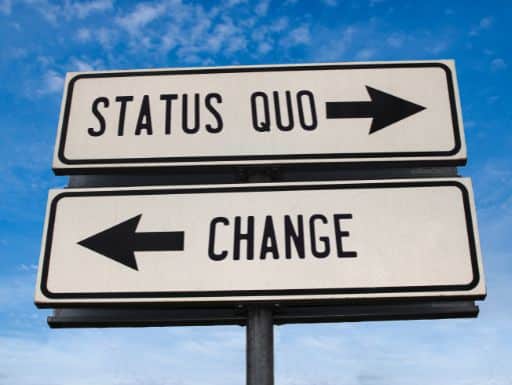Complacent: 7 Surprising Ways Your Past Successes Limit Future Success

I have to admit, I have been both the beneficiary of capitalizing on others’ complacency as well as being the dupe who became complacent and missed out on opportunities. Perhaps you’ll be able to learn from both my successes and failures so that you can identify the opportunities in your own industry. Maybe even recognize the warning signs and break bad habits.
COMPLACENT (definition): marked by self-satisfaction, especially when accompanied by unawareness of actual dangers or deficiencies (Merriam-Webster).
Complacent: 7 Surprising Ways that Your Past Success May Limit Your Future Success
- Stagnation in the Marketplace is Often Caused by Complacency.
- Hunger for Success Causes Us to Look for Opportunities.
- The Bigger the Ship, the More Time It Takes to Steer Away from Danger.
- The Skills and Knowledge that We Acquire to become Successful Creates a Perception of Loss If We Change.
- The Devil You Know is Better than the Devil You Don’t.
- The “Avis: We Try Harder” Effect.
- The Complacency of Others that Allows Us to Succeed Sometimes Envelops Us as Well.
1) Stagnation in the Marketplace is Often Caused by Complacency.
In the early 1900s, psychologists and self-help gurus alike created a theory about human potential that has been distorted and misunderstood to the extreme in recent years. For instance, in the foreword to Dale Carnegie’s book, How to Win Friends and Influence People, Thomas Howell says the following: “Professor William James of Harvard used to say that the average man develops only ten percent of his latent mental ability.”
(I personally believe that this is the most misunderstood statement in all of self-help books.)
What Howell is saying is that people rarely tap into their potential. We are all capable of more than we give ourselves credit for. However, many people read that statement and think, “Oh, we are only tapping into 10% of our brain power.” Pay close attention to this next bit: Those are two totally different statements.
The good news is, to fight this, learn a new skill or get out of your comfort zone. Doing one or both of these things will tap into new ideas and utilize your brain’s ability in new ways.
This Misunderstanding has Caused Significant Confusion.
Motivational speakers and comic book creators misunderstood. Stan Lee created The Incredible Hulk. (Stan Lee is the old guy who makes cameo appearances in all of the Marvel films.) The Hulk is the alter-ego of scientist Dr. David Banner, who was trying to figure out how to tap into the dormant human power when something went very wrong. In recent years, Bradley Cooper starred in the movie Limitless. A couple of years later, Scarlett Johansson starred in Lucy. All of these are misinterpretations of the same theory.
What Howell and James were saying is that most people stop trying to develop new skills after their formal education is complete. In reality, the failure to tap into that latent, untapped potential is almost entirely complacency. Human beings will work to achieve success up to the point where we feel like we are satisfied. We then stop doing the things that we did to get there and rely on our past successes. This repetitive behavior and a person’s years of experience keep them comfortable in their current situation or job roles.
Real Examples of How this Challenge Appears
A very easy place to see this in action is in a salesperson’s sales cycle. A new salesperson will work to prospect new clients with great vigor. They often don’t see a lot of success right away. However, they will next see a trickle of new contracts from all of that work. Finally, it seems like the flood gates open. Contract after contract comes in. The salesperson is rolling in commission. It is easy to become complacent at this point. Eventually, the sales dry up. To compensate, this salesperson will have to work even harder now to re-fill his or her sales pipeline.
Although the sales cycle example is obvious from the outside looking in, many of us have similar situations in our careers as well. For instance, in the early days of The Leader’s Institute ®, I spent a lot of time working on publishing great content on my website in order to get links from other websites. That hard work paid off as my websites ranked higher and higher on search engines. When we finally got to the #1 spot for dozens and dozens of keywords, we slowed down.
Because of all of the work put in, though, we stayed at that #1 spot for years. Then, all of a sudden, we dropped significantly. It took years to get back. The lesson here is that when you accomplish a tough goal, always set a more challenging goal right away. You will continue to grow and tap into that untapped potential. Without new goals to work toward, your brain will gain a false sense of security, and this security can be the catalyst to allow complacency to creep in.
2) Hunger for Success Causes Us to Look for Opportunities.

During the six years that I was with the company, though, the marketplace changed dramatically. I started noticing that we were averaging fewer and fewer people going through the leadership class each year. I also noticed that more and more people were coming through my classes saying, “Man, three months… That is really hard to commit to.” For three years, I begged my boss to offer more courses that had a shorter duration. Year after year, though, income dropped for the company.
Hunger Eliminates Complacency.
In those last few years, I had to work unbelievably hard to make sure that my income didn’t suffer. I was one of the few instructors for the company who didn’t see a significant cut in pay in those years, but it was because I worked so much harder than anyone else. Finally, it got too hard, and I quit. I started The Leader’s Institute ®, and we specialized in 2-day classes.
The first couple of years were tough because I was just starting out. However, after my fourth year in business, we were teaching over 300 classes per year. (The most I had ever taught in a year at my previous company was 5.) My old company was complacent. They were living on their past successes. I was hungry. Within six years, my start-up was making as much revenue each year as the company that I left. A corporate culture of complacency can breed employee complacency and lead to disengaged employees.
Interestingly, though, after a decade of fast growth, I became complacent as well. I almost missed the next trends.
3) The Bigger the Ship, the More Time It Takes to Steer Away from Danger.
In Search of Excellence: Lessons from America’s Best-Run Companieshttps://t.co/ekJHFXXLZh
Thomas J. Peters (Author), Robert H. Waterman Jr. (Author) #Ad pic.twitter.com/ZbCO5pcluD
— Rock Avenue Mall (@RockAvenueMall) April 23, 2018
Back in 1982, Tom Peters and Robert Waterman wrote a book called In Search of Excellence. The book listed a series of case studies about “Excellent” companies. The premise was that if we did in our companies what the excellent managers did in these big companies, we’d be successful as well. The big problem that the authors didn’t anticipate was complacency. 32 publicly traded “Excellent,” companies were listed in the case studies.
10 of the 32 companies have increased their success significantly in the last 30 years. Among these are companies like Intel, Walt Disney, and Wal-Mart. Three companies are at almost the exact same level today as they were 30 years ago (little or no growth in three decades). These companies include Avon, IBM, and Proctor & Gamble. So basically, about half of the companies have either stayed “excellent” or become even more “excellent.”
K-Mart vs. Wal-Mart- Big Companies are hard to Change
The rest of the list is full of companies that got complacent. For instance, although Wal-Mart did really well in the last 30 years, another pick in the book was K-Mart. K-Mart stuck to its tried and true direct-to-store delivery. Wal-Mart innovated and designed a hub-and-spoke and IT-focused delivery system. (See MarketWatch article about these companies.)
Another company listed was Kodak. I’m sure there were hundreds (if not 1000’s) of employees working for Kodak in the late ’80s and early ’90s who were saying, “Maybe photo paper isn’t exactly going to be the future of photography.” But, the ship was hard to turn. They had beaten Polaroid. Kodak was one of the most respected companies in the world. But they got complacent. A good idea can still be great as long as staff fight the risks of complacency. Good ideas need to adapt, just like we as people need to adapt and learn to improve.
Other books like Built to Last and Good to Great have had similar results. The point is that the success of these companies can often lead to their downfall if they don’t adapt quickly to changes in the marketplace. One of the reasons that my company did so well with our presentation skills classes is that our classes were created at a time when presentations were changing dramatically and quickly. Since we were so small, we experimented with new technology. The things that worked well we kept. Anything that didn’t work well, we got rid of. We were adapting quickly to the changing market. The larger companies couldn’t do that.
4) The Skills and Knowledge that We Acquire to become Successful Creates a Perception of Loss If We Change.
This challenge occurs in both companies and in individuals. I’ll give an example that is a little outside of my expertise (so if you are in this industry, don’t send me hate mail). Photography has changed dramatically with smartphones. Just a decade ago, if you wanted a great family portrait or a professional photograph, you had to hire a professional photographer to get the best results. Today though, with smartphones, Photoshop, and an internet connection, even a novice photographer can create some pretty professional images. The big question is, how many professional photographers have exchanged their expensive cameras for iPhones? I’d guess not many. (Yet.)
It takes years of skill development to become a professional photographer. Getting the light just right is critical. Using past experiences to drive and set shoot locations. Learning the potential risks of editing experiments. The equipment (and the skill to use the equipment) has always been one of the main barriers to entry in this industry. So, it would be really difficult just to flush all of that knowledge and start over.
I had a similar challenge early in my career. My Bachelor’s Degree is in Petroleum Land Management. (I was planning on becoming the next J. R, Ewing.) However, when I graduated from school, the price of oil was at a 30-year low. It took me four years to finally shift to an entirely new industry after school. (However, in retrospect, it was one of the best decisions that I ever made.) That career reset could’ve easily been a near-miss opportunity to tap into my full potential.
5) The Devil You Know is Better than the Devil You Don’t.
In 2009, we finally centralized our customer relationship management (CRM) for my company. Up to that point, we had been using a newsletter web form service to keep track of our customer and prospect contact information. We had really outgrown that software, but we stuck with it because we were all used to it. Over the years, we built this CRM into a series of automatic email follow-up campaigns for both customers and non-customers. We tested all of the emails over and over. We refined the system over time until we had it down to a money-making machine. New updates for the CRM came out from time to time, but we stuck with what was working.
Over time, challenges came up with the CRM, but we just put patched it up as best we could. New CRM products came onto the market that would have helped us grow more quickly. But each would have created a significant time investment and monetary investment for us. So, we stuck with what we had.
Eventually, we rebuilt the whole system from scratch. Sales increased dramatically the first month after the release of the new system. We were kicking ourselves for waiting so long.
6) The “Avis: We Try Harder” Effect.
Years ago, Hertz was the number one car rental company, and Avis was number two. Avis created a whole marketing campaign called, “We try harder.” They were acknowledging that they were not yet number one. They were also insinuating that the number one company had become complacent. (And they hadn’t.) There is a mentality that often slips into the culture of top companies where once you become number one, you automatically assume you will always be number one. However, the number two, three, four, and 1000 companies are always working harder to move up.
Last year, Samsung passed up Intel as the number one chip maker in the world. Intel was one of those “excellent” companies from the 1982 book. A recent article on The Verge talks about how Apple will be replacing the Intel processors in their Mac’s with Apple created processors. The reason for the breakup was that improvements in the Intel processors have stagnated. Apple believes that its own chips on the iPhone have passed the quality of the Intel-created computer processors, now.
We’ll see how Intel responds to getting knocked out of the top spot. They may re-vamp their organization and “try harder.”
7) The Complacency of Others that Allows Us to Succeed Sometimes Envelops Us as Well.
I mentioned this one earlier, but it is important to reinforce this important point. As we grow as employees, managers, and business owners, we are in a constant state of improvement. We look for any edge that we can create or exploit in the marketplace. Once we start to experience success, though, it is really easy for the same activities that made us successful to allow others to replace us. The best way to ensure that this doesn’t happen is to continue to grow in skills and knowledge. You can tap into that additional untapped potential that we talked about in the first point above if you do.
